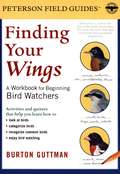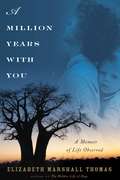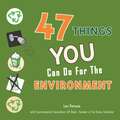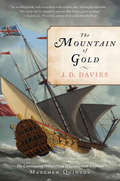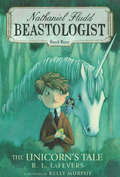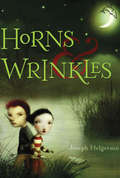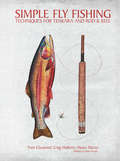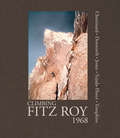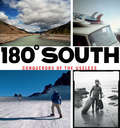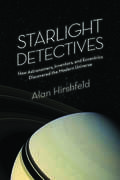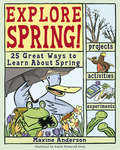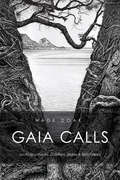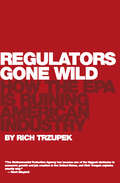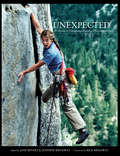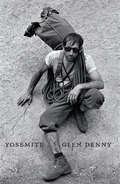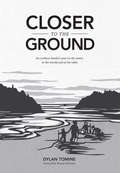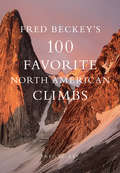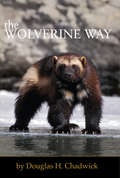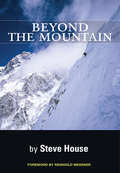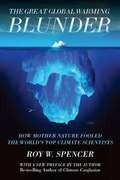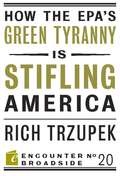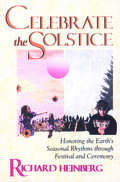- Table View
- List View
Environmentalism: How You Can Make a Difference
by Mary Mcintyre ColeyDescribes what environmental activism is and serves as a guide explaining how youth can make change in their world.
Finding Your Wings
by Burton S. GuttmanA Workbook for Beginning Bird WatchersNo other book for beginning bird watchers involves the reader so actively in the exciting first steps of learning to watch birds. This workbook is filled with quizzes and exercises that prepare the reader for going birding and help beginners develop a sense of accomplishment and progress. With each chapter covering a different aspect of bird watching, the author guides readers along a threefold path: learning how to really see birds, how to sort birds by category, and how to learn the easiest birds first. Plenty of room is provided for writing and sketching, and answers are supplied in the back of the book.
A Million Years with You
by Elizabeth Marshall ThomasOne of our greatest literary naturalists turns her famed observational eye on herself in this captivating memoir. How is it that an untrained, self-taught observer and writer could see things that professional anthropologists often missed? How is that a pioneering woman, working in male-dominated fields, without sponsors or credentials, could accomplish more than so many more celebrated and professionally educated men could manage? How can we all unlock the wisdom of the world simply by paying close attention? With their intelligence and acute insight into other cultures and species, Elizabeth Marshall Thomas's many books have won a wide and loving audience. In A Million Years with You, this legendary author shares stories from her life, showing how a formative experience in South West Africa (now Namibia) in the 1950s taught her how to pay attention to the ancient wisdom of animals and humankind. As a young woman, Marshall Thomas joined her family on an anthropological expedition to the Kalahari Desert, where she conducted fieldwork among the Ju/wa Bushmen, later publishing her findings as The Harmless People. After college, a wedding, and the birth of two children, she returned to Uganda shortly before Idi Amin's bloody coup. Her skills as an observer and a writer would be put to the test on many other occasions working with dogs, cats, cougars, deer--and with more personal struggles. A Million Years with You is a powerful memoir from a pioneering woman, an icon of American letters.
47 Things Teens Can Do for the Environment
by Lexi Petronis Jill BuckSure, we all know the planet is in trouble. We hear talk all the time about climate change, air pollution from cars, oil spills into oceans, trash overflowing into waterways, and toxic chemicals leaking into our groundwater. Sigh. But the good news is there's a lot we can do to start cleaning up the Earth. And it starts with you! This book explores tons of small (and big) things that teens can do to make a positive difference in the environment such as: * go on a green date with a new crush * eat less meat * learn to shop vintage * create an environmental task force at school * go on an eco-adventure * and more!
The Mountain of Gold
by J. D. DaviesBeset by pirates, Knights of Malta, and saboteurs, Matthew Quinton sails to Africa in this buoyant sequel to Gentleman Captain.When a captured Barbary pirate saves his neck with the story of a fabled mountain of gold, Captain Matthew Quinton has his doubts. But King Charles II can't resist the chance to outstrip the Dutch with a limitless source of wealth. With the devious corsair aboard, Quinton embarks on a voyage beyond the map's edge, still convinced that the mountain is mere legend. But as attempts to sabotage his mission draw closer to the mark, he begins to wonder ...Back in England, the king has arranged a wedding between Matthew's elder brother, the Earl of Ravensden, and a mysterious lady rumored to have murdered her previous two husbands. Resolved not to fail his meddlesome sovereign, and to return home in time to protect his family and his home, Captain Quinton approaches the coast of Africa with a troubled mind.
The Unicorn's Tale (Nathaniel Fludd, Beastologist, Book #4)
by R. L. LaFevers Kelly MurphyIs there no rest for the travel worn and weary? Not if you're Nathaniel Fludd, the world's youngest beastologist-in-training! All Nate really wants is to track down his missing parents, but when a unicorn falls mysteriously ill, Nate's Aunt Phil makes it clear where a beastologist's duty lies: to the beasts. And if taking care of the world's beasts isn't difficult enough, Nate and Aunt Phil must also keep them safe from the villainous Obediah Fludd, who intends to do them harm. With all this taking up every last bit of his energy and time, will Nate ever find the parents he is so absolutely convinced are alive?
Horns and Wrinkles
by Nicoletta Ceccoli Joseph HelgersonHow can you tell if a river's under a spell? River trolls, rock trolls, blue-wing fairies-the usual suspects. The stretch of the Mississippi where Claire lives has rumors of them all, not that she's ever spotted any. But then Claire's cousin Duke takes a swim and sprouts a horn-a long, pointy, handsome thing. After that, Claire doesn't have much choice but to believe that something rivery is going on, especially since she's the only one who can help Duke lose his new addition.
Simple Fly Fishing
by James Prosek Yvon Chouinard Craig Mathews Mauro Mazzo Russell ChathamModern-day fly fishing, like much in life, has become exceedingly complex, with high-tech gear, a confusing array of flies and terminal tackle, accompanied by high-priced fishing guides. This book reveals that the best way to catch trout is simply, with a rod and a fly and not much else. The wisdom in this book comes from a simpler time, when the premise was: the more you know, the less you need. It teaches the reader how to discover where the fish are, at what depth, and what they are feeding on. Then it describes the techniques needed to present a fly at that depth, make it look lifelike, and hook the fish. With chapters on wet flies, nymphs, and dry flies, its authors employ both the tenkara rod as well as regular fly fishing gear to cover all the bases. Illustrated by renowned fish artist James Prosek, with inspiring photographs and stories throughout, Simple Fly Fishing reveals the secrets and the soul of this captivating sport.
Climbing Fitz Roy, 1968
by Lito Tejada-Flores Chris Jones Yvon Chouinard Doug Tompkins Dick DorworthThis book features rare, once-thought-lost photos of the 1968 first ascent of the California Route on Cerro Fitz Roy, the third ascent of the mountain. With accompanying retrospective essays. Climbing Fitz Roy,1968, presents photo documentation of the climb, places it in the social and climbing context of the times, and reflects how this momentous trip influenced the lives of those involved, and in a greater context, the lives of so many others.
180° South
by Jeff Johnson Yvon Chouinard Doug Tompkins Chris Malloy180° South takes readers behind the scenes of the film, 180° South, made by Chris Malloy, to learn more about the people who made the original overland journey to Patagonia in 1968, and the repeat journey over ocean and land 40 years later. The book includes stories of events and experiences that inspired Chris Malloy, Yvon Chouinard, and Doug Tompkins to choose paths committed to saving what's left of the wild world. Open it anywhere and enjoy the photographs by the world's leading surf and climbing photographers Jeff Johnson, Jimmy Chin, Scotty Soen, and Danny Moder.
Starlight Detectives
by Alan HirshfeldDiscover magazine "Top 5 Summer Read"Scientific American "Recommended" feature review"A masterful balance of science, history and rich narrative." -Discover magazine"Starlight Detectives is just the sort of richly veined book I love to read-full of scientific history and discoveries, peopled by real heroes and rogues, and told with absolute authority. Alan Hirshfeld's wide, deep knowledge of astronomy arises not only from the most careful scholarship, but also from the years he's spent at the telescope, posing his own questions to the stars." -DAVA SOBEL, author of A More Perfect Heaven: How Copernicus Revolutionized the Cosmos and LongitudeIn 1929, Edwin Hubble announced the greatest discovery in the history of astronomy since Galileo first turned a telescope to the heavens. The galaxies, previously believed to float serenely in the void, are in fact hurtling apart at an incredible speed: the universe is expanding. This stunning discovery was the culmination of a decades-long arc of scientific and technical advancement. In its shadow lies an untold, yet equally fascinating, backstory whose cast of characters illuminates the gritty, hard-won nature of scientific progress.The path to a broader mode of cosmic observation was blazed by a cadre of nineteenth-century amateur astronomers and inventors, galvanized by the advent of photography, spectral analysis, and innovative technology to create the entirely new field of astrophysics. From William Bond, who turned his home into a functional observatory, to John and Henry Draper, a father and son team who were trailblazers of astrophotography and spectroscopy, to geniuses of invention such as Léon Foucault, and George Hale, who founded the Mount Wilson Observatory, Hirshfeld reveals the incredible stories-and the ambitious dreamers-behind the birth of modern astronomy.Alan Hirshfeld, Professor of Physics at the University of Massachusetts Dartmouth and an Associate of the Harvard College Observatory, is the author of Parallax: The Race to Measure the Cosmos, The Electric Life of Michael Faraday, and Eureka Man: The Life and Legacy of Archimedes.
Explore Spring!
by Lauri Berkenkamp Alexis Frederick-FrostFrom tracking spring peepers and raising tadpoles to learning about seeds and recording plant growth, Explore Spring! 25 Great Ways to Learn About Spring invites young readers to explore the wonders of spring by becoming scientists in the field. Combining hands-on learning with solid science, trivia, riddles, and terrific illustrations, projects investigate "the reason for the season" and include identifying trees and measuring their growth, recording soil temperature, and observing the forest floor. Bird migration and nest building are covered, and the movement of air and water is studied with experiments in capillary action and in such activities as "Making Parachutes," Making Kites," and "Mapping Air Currents with Bubbles."
Gaia Calls
by Wade DoakWade Doak is one of the world's leading marine explorers. In Gaia Calls he takes his readers on a unforgettable journey. From his first discovery of the sunken treasure of the Elingamite, to life as a young man in the Solomon Islands living among the islanders, to years of dolphin research, diving adventures, and his discovery of interspecies communication. With patience, focus, and respect he shares his knowledge and love for the natural world, and leads his readers to a deeper understanding of the interconnectedness of all life. A fascinating and engaging document of a life well lived.
Regulators Gone Wild
by Rich TrzupekRich Trzupek has spent over 25 years engaged in combat with the environmental movement on the front lines, helping America's industrial sector defend itself against the increasingly aggressive tactics that environmental advocacy groups and their allies in the Environmental Protection Agency employ. In Regulators Gone Wild Trzupek lays out the inside story that describes the way the green/big government alliance has combined to stifle American productivity and hamstring American innovation, not by design, but as the inevitable consequence of pursuing a utopian vision of environmental purity that can never, ever be realized.As a respected scientist and consultant, Rich Trzupek has been employed by some of America's largest corporations and by some of its smallest, most innovative entrepreneurs. Those experiences have provided him with a unique perspective. While many of his colleagues in the industrial consulting community only consider the short-term profit opportunities that an overly aggressive EPA provides them, Trzupek takes a longer view. If the EPA continues to hamstring America's ability to create wealth, everyone loses.When it comes to today's environmental issues, most of the public's attention is focused on the issue of "climate change" and initiatives to reduce fossil fuel use and greenhouse gas emissions. As a climate change skeptic, Trzupek argues against these measures, but he sees the rise of this issue as another inevitable step in a progression that spans four decades during which the green movement has continually sought new ways to control industry and the EPA has always happily obliged them. Attempts to restrict America's use of cheap, plentiful coal and stop oil exploration are just the latest examples of regulators gone wild.
The Bad Science and Bad Policy of Obama's Global Warming Agenda
by Roy W. SpencerAs the U.N. moves closer to a new global warming treaty, it is time to examine the calls for reductions in greenhouse gas emissions. The health and welfare of humanity has benefited from access to fossil fuels, and any drastic move to limit that access must have extraordinary evidence to support it.While alternative energy technologies will increasingly be relied upon in the face of dwindling fossil fuel supplies, leading climate researcher Dr. Roy W. Spencer argues that the free market is the best mechanism for solving the problem. In addition, Dr. Spencer addresses the new science that suggests that our modern fears of anthropogenic global warming might well be unfounded, because the climate system itself might be responsible for causing what is now known as "climate change."
UNEXPECTED
by Rick Ridgeway Jennifer Ridgeway Jane SievertFrom the peak of a mountain or the barrel of a wave, Patagonia has collected some of the most spectacular sports imagery in history. Relive the achievements captured in Patagonia's history, as well as the joie de vivre fostered by nurturing a relationship with the great outdoors.Unique for a business enterprise, Patagonia's catalog devotes fully half its space to nonselling editorial content - to environmental and sport essays and above all to extraordinary photographs of wild places and active pursuits for which the company makes its clothes. Since 1980, Patagonia has invited customers and wilderness photographers to submit their best, most unexpected shots of life outdoors - of alpine climbing, bouldering in the desert, skiing untracked bowls, surfing secret spots, ocean crossings, first kayak descents and travel in unfamiliar places. The photos have poured in ever since (current rate: 60,000 per year), some from the famous (John Russell, Galen Rowell), others from respected photographers (Corey Rich) who had their first work published in these pages. Jane Sievert and Jennifer Ridgeway, Patagonia's current and founding photo editor, respectively, have been calling - and culling - the shots for three decades. This is their compendium of the 100-plus most compelling photos Patagonia has published - and a celebration of wilderness and outdoor-sport photography as an art and a practice.
YOSEMITE IN THE SIXTIES
by Yvon Chouinard Steve Roper Glenn DennyThe sheer granite walls of Yosemite Valley galvanized a dedicated group of rock climbers in the 1960s, who saw the nearly holdless, glacier-polished faces as the purest form of challenge. The awesome Half Dome and El Capitan were first climbed in the late 1950s, ushering in a new era of rock climbing later known as the golden age of Yosemite climbing. During this era, the climbers of the sixties developed the techniques, tools, and philosophies that made Yosemite the most influential rock climbing arena in the world. In the spirit of the social changes of the sixties, a small group of committed climbers dropped out of mainstream work and society and took up residence in Camp 4, perfecting their skills and developing a unique social scene. This austere, boulder-strewn campground became the epicenter of the climbing world. It served both as a launching pad for spectacular feats and adventures and a refuge from them. Here plans were made, teams were formed, and the rest of life was lived. The significance of Camp 4 was recently recognized with its placement on the National Register of Historic Places.
Closer to the Ground
by Thomas Mcguane Nikki Mcclure Dylan TomineCloser to the Ground is the deeply personal story of a father learning to share his love of nature with his children, not through the indoor lens of words or pictures, but directly, palpably, by exploring the natural world as they forage, cook and eat from the woods and sea. With illustrations by Nikki McClure.This compelling, masterfully written tale follows Dylan Tomine and his family through four seasons as they hunt chanterelles, fish for salmon, dig clams and gather at the kitchen table, mouths watering, to enjoy the fruits of their labor. Closer to the Ground captures the beauty and surprise of the natural world-and the ways it teaches us how to live-with humor, gratitude and a nose for adventure as keen as a child's. It is a book filled with weather, natural history and many delicious meals.
Fred Beckey's 100 Favorite North American Climbs
by Barry BlanchardFred Beckey's 100 Favorite North American Climbs is the magnum opus of the greatest American climber of the past century. Fred's intimate, detailed knowledge of the mountains and climbs he chronicles here create an unparalleled guidebook and must-have for every climber's bookshelf - as well as a great read for any armchair adventurer. Filled with hand-drawn climbing topos, photos, narrative description, side notes and 40 extra climbs of note in each of the eight geographical regions. This is the guide for every climber's bookshelf.
The Wolverine Way
by Douglas H. ChadwickGlutton, demon of destruction, symbol of slaughter, mightiest of wilderness villains... The wolverine comes marked with a reputation based on myth and fancy. Yet this enigmatic animal is more complex than the legends that surround it. With a shrinking wilderness and global warming, the future of the wolverine is uncertain. The Wolverine Way reveals the natural history of this species and the forces that threaten its future, engagingly told by Douglas Chadwick, who volunteered with the Glacier Wolverine Project. This five-year study in Glacier National Park - which involved dealing with blizzards, grizzlies, sheer mountain walls, and other daily challenges to survival - uncovered key missing information about the wolverine's habitat, social structure and reproduction habits. Wolverines, according to Chadwick, are the land equivalent of polar bears in regard to the impacts of global warming. The plight of wolverines adds to the call for wildlife corridors that connect existing habitat that is proposed by the Freedom to Roam coalition.
Beyond the Mountain
by Reinhold Messner Steve HouseWhat does it take to be one of the world's best high-altitude mountain climbers? A lot of fundraising; traveling in some of the world's most dangerous countries; enduring cold bivouacs, searing lungs, and a cloudy mind when you can least afford one. It means learning the hard lessons the mountains teach.Steve House built his reputation on ascents throughout the Alps, Canada, Alaska, the Karakoram and the Himalaya that have expanded possibilities of style, speed, and difficulty. In 2005 Steve and alpinist Vince Anderson pioneered a direct new route on the Rupal Face of 26,600-foot Nanga Parbat, which had never before been climbed in alpine style. It was the third ascent of the face and the achievement earned Steveand Vince the first Piolet d"or (Golden Ice Axe) awarded to North Americans.Steve is an accomplished and spellbinding storyteller in the tradition of Maurice Herzog and Lionel Terray. Beyond the Mountain is a gripping read destined to be a mountain classic. And it
The Great Global Warming Blunder
by Roy W SpencerThe Great Global Warming Blunder unveils new evidence from major scientific findings that explode the conventional wisdom on climate change and reshape the global warming debate as we know it. Roy W. Spencer, a former senior NASA climatologist, reveals how climate researchers have mistaken cause and effect when analyzing cloud behavior and have been duped by Mother Nature into believing the Earth's climate system is far more sensitive to human activities and carbon dioxide than it really is.In fact, Spencer presents astonishing new evidence that recent warming is not the fault of humans, but the result of chaotic, internal natural cycles that have been causing periods of warming and cooling for millennia. More carbon dioxide in the atmosphere is not necessarily to be feared; The Great Global Warming Blunder explains that burning of fossil fuels may actually be beneficial for life on Earth.As group-think behavior and misguided global warming policy proposals threaten the lives of millions of the world's poorest, most vulnerable citizens, The Great Global Warming Blunder is a scintillating exposé and much-needed call for debate.
How the EPA's Green Tyranny is Stifling America
by Rich TrzupekThe relationship between environmental regulation and economic growth has gone from dysfunctional to disastrous under the leadership of Barack Obama's USEPA Administrator, Lisa Jackson. Jackson's EPA has assumed broad new powers and promulgated sweeping new regulations unlike anything that America has seen since the Clean Air Act and Clean Water Act were signed into law forty years ago. While much of the public has focused on the EPA's plans to regulate greenhouse gas emissions, the Agency's power grab extends into far more areas of society and the economy than fossil fuel use alone.Rich Trzupek explains why Obama's EPA is different and more dangerous, than any other since the Agency was created forty years ago. From the oceans to consumer products, from the manufacturing line to the showroom floor, the tentacles of this EPA are silently creeping into more and more parts of our lives as Lisa Jackson smilingly assures the nation that everything the EPA does generates revenue rather than costing industry billions of dollars and America hundreds of thousands of jobs.
Celebrate the Solstice
by Richard HeinbergThis book is an accessible, engaging tool to help people enrich their lives through the observance of ancient, astronomically determined Earth festivals. It assists us to recover an experience that had deep meaning for the ancients and that is now increasingly relevant to a world facing environmental challlenges. Seasonal festivals are not meant to be cultural relics. They are joyous, fun, mischievous, profound, life-affirming events that connect us deeply with the Earth, the heavens, and the wellspring of being within us. This book encourages us to undertake full-bodied, ecstatic seasonal renewal by providing information on the history and meaning of the solstices with practical suggestions on how to celebrate them now.
Man and Animal in Severan Rome
by Steven D. SmithThe Roman sophist Claudius Aelianus, born in Praeneste in the late second century CE, spent his career cultivating a Greek literary persona. Aelian was a highly regarded writer during his own lifetime, and his literary compilations would be influential for a thousand years and more in the Roman world. This book argues that the De natura animalium, a miscellaneous treasury of animal lore and Aelian's greatest work, is a sophisticated literary critique of Severan Rome. Aelian's fascination with animals reflects the cultural issues of his day: philosophy, religion, the exoticism of Egypt and India, sex, gender, and imperial politics. This study also considers how Aelian's interests in the De natura animalium are echoed in his other works, the Rustic Letters and the Varia Historia. Himself a prominent figure of mainstream Roman Hellenism, Aelian refined his literary aesthetic to produce a reading of nature that is both moral and provocative.

